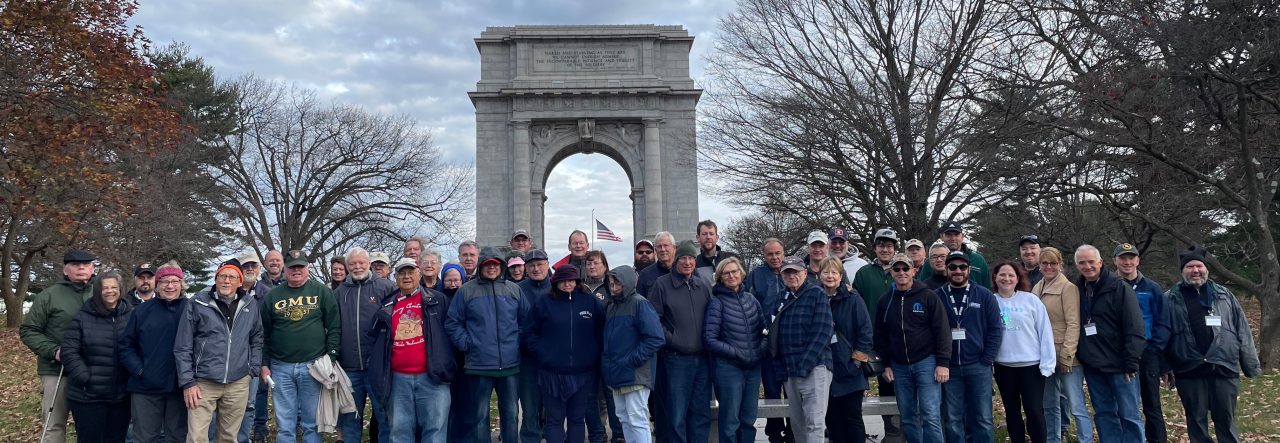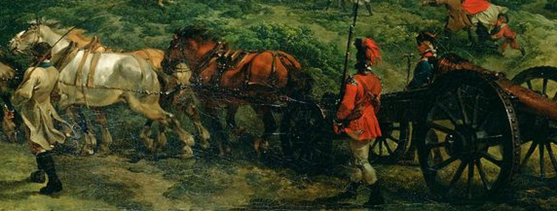Emerging Revolutionary War welcomes back guest historian Karl G. Elsea
When visiting Revolutionary War battlefields there are often replica field guns (sometimes with original barrels) on the grounds. What is often not shown is the equipment needed for the gun to get to the field. That movement required horse(s) and harness and a limber. An earlier article provided information on Patriot limbers. This article concerns the horse harness.
There are inventories and paintings that show British harness used during the war. Muller’s A Treatise of Artillery shows the horse harness hook-ups on British limbers for medium and heavy artillery, and it is somewhat unique. The British hook-up appears more restrictive as to horse size. The cart-saddle used by the British was ubiquitous. It seems reasonable that the Patriots would have used the same harness with the exception of the specialized hook-up hardware on the limber. The following part of a Philipp Loutherbourg painting of Warley Camp detailing a review in 1778 clearly shows the cart-saddle with chain on the thill horse and the rest of the British harness.
The following Colonial Williamsburg photo shows a cart-saddle with the typical “cart-saddle” hook-up on the shafts of the cart. This picture shows a perfect use. The chain across the cart-saddle supports the shafts. The wantey under the horse prevents the shafts from coming up. The collar and wooden hames provide the forward motion and the breeching (straps on horse’s butt) provides the brakes when needed. Because of the ubiquitous nature of this harness set-up this picture provides a good starting point for Patriot limber harness. A “blind” bridle is being used as was used by the Patriots in the Sullivan expedition. The “driver” is walking beside the horse thus allowing the maximum power for draft. It seems likely the Patriots used the ubiquitous horse harness cart hook-up hardware on Patriot limbers because it allowed for more horse size variations.
The Patriots also used other harness configurations during the war. For example, Proctor’s artillery in the Sullivan expedition used pack saddles in lieu of the cart-saddle. This modification would make the harness more flexible and interchangeable with other horses in that expedition.
There are also notations scattered about, such as the comment that rope tugs were used at Guilford Courthouse instead of the chain tugs as is shown in the picture above. There are also good clues to be found in unlikely places. The following 1777 Patriot sketch etched on to a powder horn of a field gun being moved provides valuable clues about the harness.
The most obvious feature is that the “driver” is on a riding saddle on the thill horse and controlling the lead horse with whip and maybe reins. This sketch of a Patriot field gun being hauled shows a striking similarity to how tobacco was hauled in Virginia.[i] In year 1800 the book, “An Historical and Practical Essay on the Culture and Commerce of Tobacco” by William Tatham shows the “old” method for moving tobacco in a hogshead from the farm to the port. This drawing below from that book provides much more detail concerning the harness used by the Patriots to move field guns as sketched above. This configuration of two horses, rider, and harness would work for a Patriot three-pounder gun and, if the roads were firm and relatively flat, a light six-pounder.
This drawing provides enough clear detail to show (and make) the horse harness necessary to move a Patriot field gun. The rider, who is also the driver, is using a bridle and reins, and whip, to control the lead horse; and, bridle and reins and leg to control the thill horse. The thill horse has a riding saddle with the stirrups removed and the shafts held in place by the stirrup straps. Following is a picture of a single horse pulling a gun with similar horse harness. A riding saddle would be useful for the many tasks related to horse needs and a means of retreat if required. Having no rider doubles the horse’s ability to pull.
The Battle of Hanging Rock provides a final note about a forgotten horse harness item, the horse bell. The Patriots heard the horse bells and thus knew they were approaching the Royal soldiers’ camp in the upcoming surprise attack. Two items often used on horses at night by both sides were hobbles and bells. At night the horses were often hobbled so they could graze without going too far and/or the horses had bells on collars that were placed on the horse so that they could be found in the morning.
[i] Harold L. Peterson, Round Shot and Rammers (Bonanza Books, New York, 1969), 59






